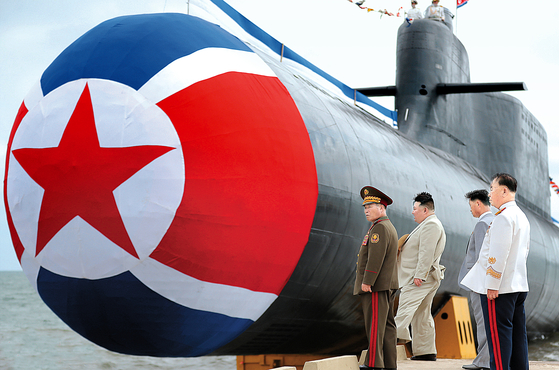This follows repeated declarations by North Korean leader Kim Jong-un that his country planned to develop such vessels.
The initial stages of the submarine’s construction were observed, according to material from the South’s Defense Intelligence Agency revealed by Rep. Kang Dae-sik of the People Power Party. The data found that it remains uncertain if North Korea will successfully implement nuclear technology.
South Korean military authorities confirmed the submarine is being constructed in Sinpo, South Hamgyong Province. Sinpo is home to the North’s submarine-related facilities.

“Details have been verified by South Korea and the United States, yet we cannot confirm further details,” said a military official. “We are continuously monitoring developments.”
North Korean leader Kim Jong-un said nuclear-powered submarines were among the advanced military assets on his wish list during the 8th Workers’ Party congress in August 2021. He had hinted that research on the submarine design was complete and had entered “the final review stage.”
Although not much more was revealed about the program for some time, Kim reiterated the plan in September last year at the launch of the so-called “tactical nuclear attack submarine” Hero Kim Kun Ok, where he pledged to enhance North Korea’s “overall underwater operational capabilities,” particularly with the new nuclear-powered submarines under development.
Kim’s drive for nuclear-powered submarines is viewed as a potential game changer in North Korea’s military strategy as it would give the country second strike capability — the ability to mount a retaliatory nuclear strike even after absorbing a first strike.
Although constructing a nuclear-powered submarine requires advanced technology, South Korean military authorities have, for the first time, confirmed that North Korea has taken initial steps toward this goal.
Challenges remain, particularly in developing a small, integrated nuclear reactor suitable for submarine use.
A South Korean government official suggested that North Korea might be conducting “secret tests on small nuclear reactors” and raised concerns about the possibility of “technical assistance from Russia,” amid growing military cooperation between the two countries.
In addition to its nuclear-powered submarine ambitions, the South Korean military has, for the first time, provided an assessment of North Korea’s underwater nuclear weapon system, known as the “Haeil” — meaning “tsunami” in Korean — believed to be an underwater nuclear torpedo.
“The weapon is still in the early testing phase but may have developed basic long-range underwater navigation technology,” said the South Korean military. Authorities also warned that “North Korea could further advance its nuclear propulsion and warhead-mounting technology through cooperation with Russia.”
North Korea claims to have conducted four tests of the Haeil between March 2023 and January 2024. Reports from North Korean state media suggest that the regime is working to extend the submarine’s underwater endurance and range. In its initial test, North Korea claimed that the weapon was designed to “stealthily infiltrate operational waters and make a super-scale radioactive tsunami through an underwater explosion.”
Despite these claims, South Korean military authorities have long believed that North Korea has exaggerated the Haeil’s capabilities, suspecting that it is battery-powered rather than nuclear-powered, and its true destructive power remains unverified. Following North Korea’s announcement of a fourth Haeil test in January, the South Korean presidential office also downplayed the claims, suggesting they were likely exaggerated or fabricated.
BY LEE KEUN-PYUNG,SEO JI-EUN [seo.jieun1@joongang.co.kr]





